If any of the six Lexus LC500s in the GT500 field win this weekend’s Fuji GT 300km Race, not only will Lexus have set the record for the most consecutive wins to open a season by a GT500 manufacturer, they’ll also tie the all-time premier class record of six wins in a row, with a streak starting in the second race of last year’s Motegi GT Grand Final.
The current record for the most consecutive GT500 victories is held by Honda, and the first-generation NSX-GT, which racked up six consecutive victories from 1998 to 1999 (plus one more in a non-championship All-Star event after the 1998 season), and we felt it only fitting to take a look back at Honda’s memorable winning streak – and look back to the dawn of Super GT’s first golden age.
1996 saw the debut of the Honda NSX in what was then known as the All-Japan Grand Touring Car Championship (JGTC). It was a privateer effort run by Team Kunimitsu, who took the same Honda NSX GT2 that won their class at the 24 Hours of Le Mans in 1995, to the GT500 class.
But it wasn’t until 1997 that Honda, with the cooperation of expert chassis builders Dome and top engine tuners Mugen, put their support behind a new NSX race car built specifically to the GT500 regulations.
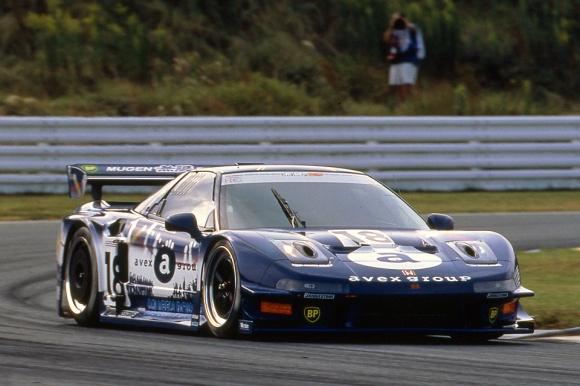
By the end of its slightly truncated debut season, the Honda NSX-GT had scored two podiums and two pole positions, at the final two races at Central Park Miné Circuit and Sportsland SUGO respectively.
It was now evident that the two-way battle between the Toyota Supras and the Nissan Skyline GT-Rs was now destined to turn into a three-way fight for GT500 supremacy starting in 1998, a three-faction rivalry that still runs today in Super GT’s premier class.
For the 1998 season, Honda doubled its efforts in GT500, expanding from two cars to four. Team Kunimitsu with Mooncraft led the charge, with the #100 Raybrig NSX piloted by the legendary Kunimitsu Takahashi and his apprentice Akira Iida. The Mugen x Dome Project expanded to two cars, with the #18 Takata Dome NSX of Katsutomo Kaneishi and Katsumi Yamamoto representing the “Dome” half of the project, and the new #16 Castrol Mugen NSX, piloted by reigning Japanese Touring Car Champion Osamu Nakako and a 25-year-old newcomer, Ryo Michigami.
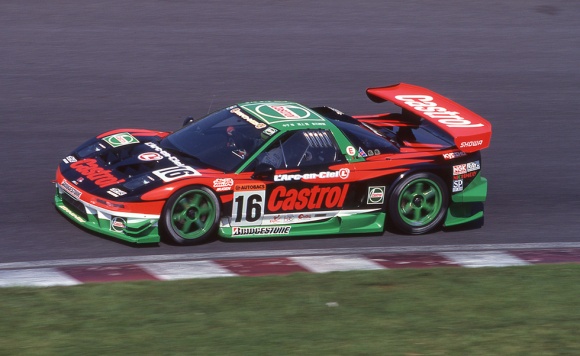
To further bolster Honda’s efforts, Japanese Formula 1 legend Satoru Nakajima brought his already-successful team from Formula Nippon to the grid, fielding the #64 Mobil 1 NSX for two outstanding rookies: Reigning Japanese F3 champion Tom Coronel, and 20-year-old single-seater prospect Koji Yamanishi.
With this four-car effort ready to roll out, Honda wasted little time stamping their authority on the season by taking pole position in the first three rounds of the championship, starting with an all-Honda front row at their home track, Suzuka Circuit.
However, a string of untimely mechanical failures and the odd crash at Suzuka and Sendai Hi-Land Raceway kept them from reaching their potential early in the seasons, and the thought of “what could have been” at Fuji Speedway in May, when Honda took another front-row lockout, was washed away in torrential rain, then burned to cinders in the appalling pace lap melee that ultimately cancelled the race.
Once again, Honda locked out the front row when the series returned to Fuji in August, and this time, they’d score their first victory as the #64 Mobil 1 NSX of Coronel and Yamanishi overcame an early off-track excursion, plus some late pressure from the legendary Masahiro Hasemi, to score Honda’s very first GT500 victory.
The next round was at Honda’s brand-new Twin Ring Motegi road course, and it would be only fitting that an NSX-GT won from another all-Honda front row, this time, it was the #16 Castrol Mugen NSX of Michigami and Nakako taking the honours in a pole-to-win performance.
Honda made it a hat-trick at Miné in the penultimate round of the 1998 season, as the #100 Raybrig NSX of Takahashi and Iida went pole-to-win at the ultra-technical circuit. That same race, JGTC fans got a glimpse of the future, as the #18 Takata Dome NSX got a new driver – in the form of top Honda single-seater prospect, Juichi Wakisaka.
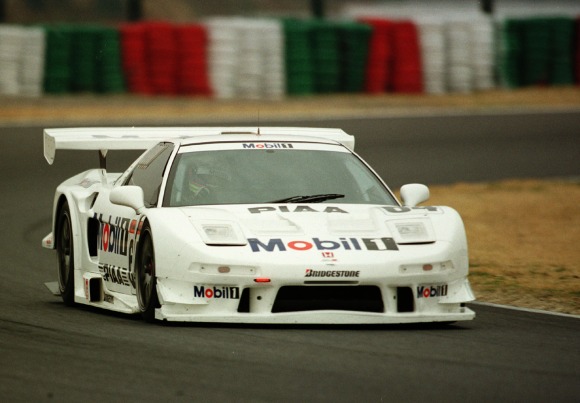
By this point, the Honda NSX-GT was developing a reputation of being GT500’s “glass cannon” – extremely effective, yet prone to fits of horrible reliability unbefitting of a car based on a road-going vehicle lauded for its dependable Honda reliability. There was also an emerging pattern of the winning NSX benefitting from silly, often cruel misfortunes inflicted upon their stablemates.
Despite this, the Mobil 1 NSX of Coronel & Yamanishi actually had an outside chance to win the title in the final race of the 1998 season at Sportsland SUGO. They needed at least a podium to have a chance, and Coronel was determined to charge through from fifth on the grid, 90 kilograms of Success Ballast be damned.
Their championship hopes perished before the green flag even waved, when a drivetrain failure brought the Mobil 1 NSX to an agonizing halt on the ascent through the 110R corner on the pace laps.
Once again, the duality of Honda would come to the forefront during the race itself: The #18 Takata Dome NSX of Kaneishi and Wakisaka finished first on track, but a technical infraction stripped them of the win, which then went to their Mugen/Dome stablemates, the Castrol Mugen NSX of Michigami and Nakako.
Even though Honda could understandably feel frustrated with the lack of consistency and falling short of a GT500 championship, the NSX-GT finished the season with four wins to close out the season, plus a perfect seven pole positions out of seven qualifying sessions. Just for good measure, the Mobil 1 NSX closed out 1998 with a win in the NicoS Cup All-Star Race at TI Circuit Aida, now known as Okayama International Circuit, in a non-championship event.
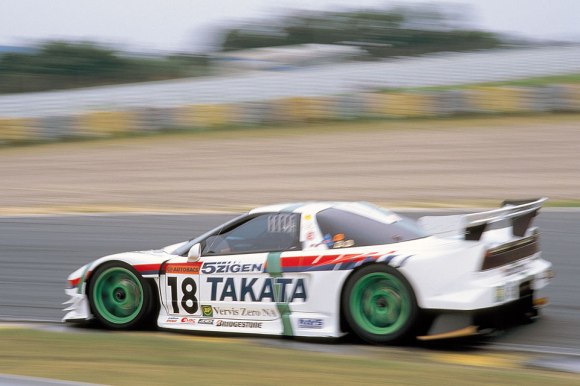
1999 would start at Honda’s home track at Suzuka, and perhaps enraged by the way their season-ending victory was stripped from them, Kaneishi and Wakisaka powered their way through the heavy rains and converted pole position into a first win for the Takata Dome NSX, and what was now a fifth consecutive victory for the unbeatable Honda NSX-GT.
When the series returned to Fuji Speedway for the Golden Week race, the conditions were thankfully fine, dry, and free of fog – and this time, there would be no question of who had the fastest car on the day.
The #100 Raybrig NSX simply outdrove the field on the afternoon of May 2, 1999, with Iida building up a whopping margin at the start, and the 59-year-old legend Takahashi sealing the deal in his closing stint to emphatically secure a piece of JGTC history for Honda with their sixth consecutive JGTC victory, spanning two seasons, nine months, and five different circuits.
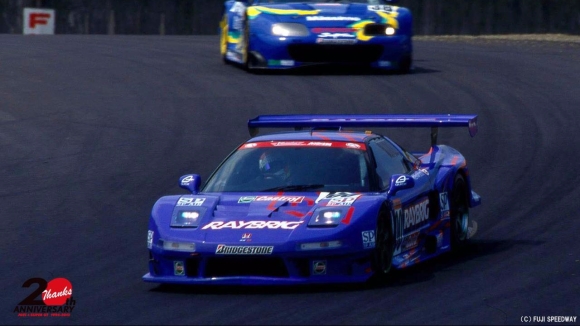
Ultimately, the streak would come to an end for Honda, as Toyota took a 1-2 finish in Round 3 at Sportsland Sugo – but no manufacturer has ever matched Honda’s six-race winning streak since.
They’d eventually go on to win the championship via the Castrol Mugen NSX and Ryo Michigami in 2000, but by then, there’d be tumultuous times at Honda. Kunimitsu Takahashi retired from driving at the end of the 1999 season. By 2001, Iida and Wakisaka would defect from Honda to Toyota. Coronel went to Europe to try and chase his Formula 1 dream. Yamanishi’s form in 1999 sharply declined to the point that he was replaced before the end of the year – and his career never really recovered from there. Nakako, at age 46, suddenly retired from the series when he was no longer physically fit enough to race in GT500. Eventually, Aguri Suzuki would take his Autobacs Racing Team Aguri (ARTA) outfit to Honda as well, adding a fifth team to the mix.
Even in the early days of the JGTC, for one manufacturer to win six races in a row in a series built around competitive parity was astonishing. In the two decades since, the push for parity has increased, and the drivers and the teams have become even more closely matched than before.
That’s what makes what Lexus has accomplished in 2016 and 2017 even more incredible, and for them to be within one race win of matching a record that many thought would never be approached – one of the rare untouchable records in Super GT’s brief history – is something that should really be appreciated, no matter where your allegiances as a GT500 supporter lie.
Whether Lexus match the streak this weekend, or if their current run comes to an end – maybe at the hands of the new Honda NSX-GT – there will always be many, many fond memories of Honda’s run of six in a row nearly twenty years ago.
Other fun facts about the 1998-99 Honda win streak:
- Honda also set a record of ten consecutive GT500 pole positions from 1997-1999, and eight consecutive fastest race laps from 1998-99. They were also the last manufacturer, and the second ever, to win pole and take fastest lap in every round of a season (after McLaren in 1996).
- Kunimitsu Takahashi (59 years) and Koji Yamanishi (20 years, 9 months, 29 days) set the records for oldest, and youngest, GT500 race winners respectively during the streak.
- Takahashi’s victory at Fuji in 1999 was also his very last win as a professional racing driver in a career that spanned 42 years between motorcycles and cars.
- Tom Coronel became the first Dutch driver to win a GT500 race.
- Coronel, Yamanishi, Michigami, Nakako, and Wakisaka all became race winners in their rookie years in the JGTC.
- Only two of Honda’s six victories came with the winning car carrying any Success Ballast on board – the rest were ballast-free.
